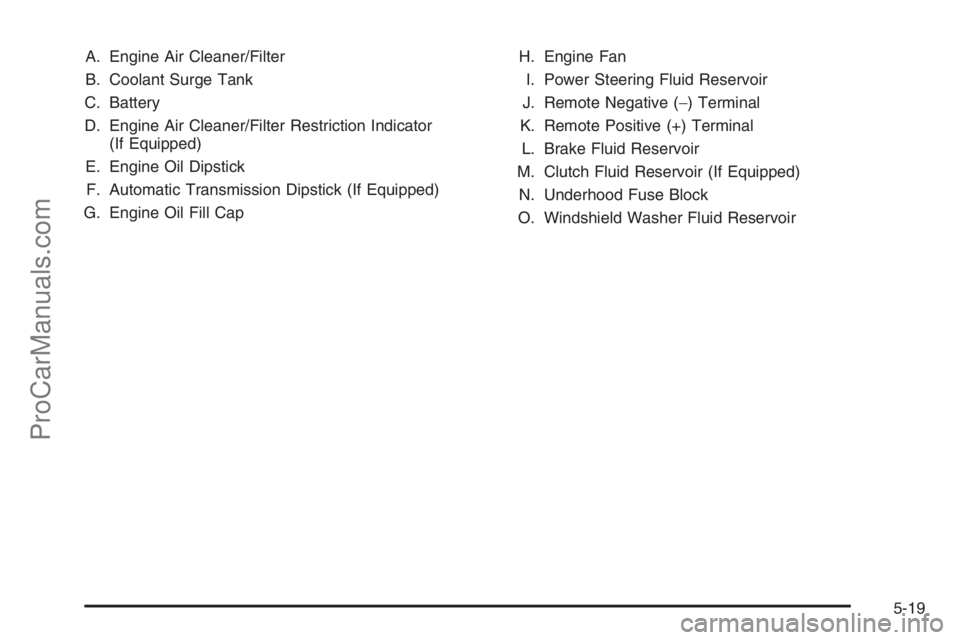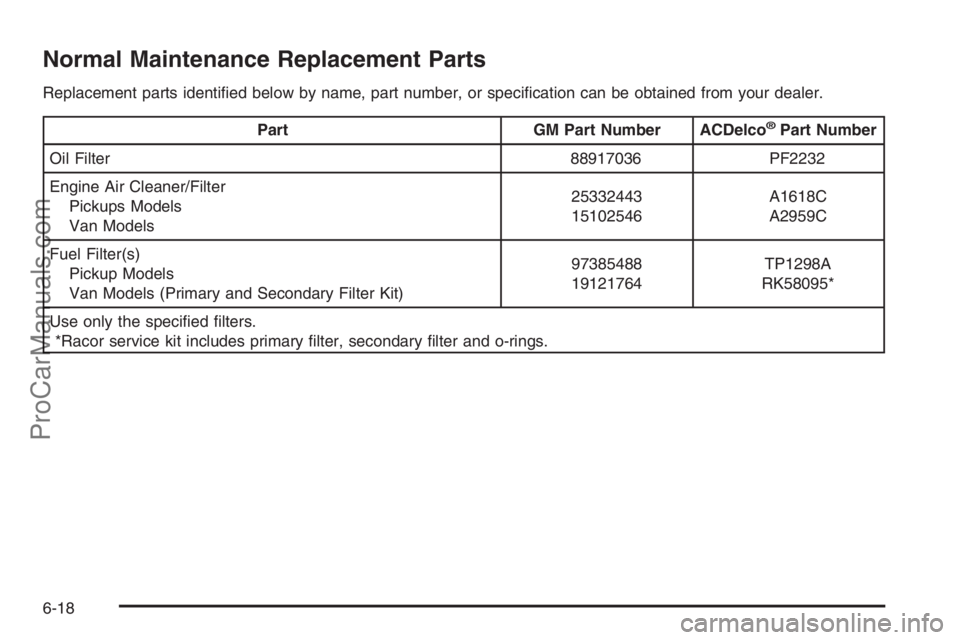2006 CHEVROLET DURAMAX air filter
[x] Cancel search: air filterPage 25 of 100

Diesel Fuel Requirements and Fuel System.......5-2
Diesel Engine Fuel.........................................5-2
What Fuel to Use...........................................5-3
Very Cold Weather Operation...........................5-5
Water in Fuel.................................................5-5
Water in Fuel Light Chart................................5-6
Running Out of Fuel.....................................5-11
Fuel Filter Replacement.................................5-12
Filling the Tank............................................5-15
Filling a Portable Fuel Container.....................5-17Checking Things Under the Hood....................5-18
Engine Compartment Overview.......................5-18
Engine Oil...................................................5-21
Engine Oil Life System..................................5-24
Engine Air Cleaner/Filter................................5-25
Automatic Transmission Fluid.........................5-29
Engine Coolant.............................................5-34
Radiator Pressure Cap..................................5-39
Coolant Surge Tank Pressure Cap..................5-39
Engine Overheating.......................................5-39
Cooling System............................................5-41
Capacities and Speci�cations..........................5-50
Specification Charts......................................5-50
Section 5 Service and Appearance Care
5-1
ProCarManuals.com
Page 43 of 100

A. Engine Air Cleaner/Filter
B. Coolant Surge Tank
C. Battery
D. Engine Air Cleaner/Filter Restriction Indicator
(If Equipped)
E. Engine Oil Dipstick
F. Automatic Transmission Dipstick (If Equipped)
G. Engine Oil Fill CapH. Engine Fan
I. Power Steering Fluid Reservoir
J. Remote Negative (−) Terminal
K. Remote Positive (+) Terminal
L. Brake Fluid Reservoir
M. Clutch Fluid Reservoir (If Equipped)
N. Underhood Fuse Block
O. Windshield Washer Fluid Reservoir
5-19
ProCarManuals.com
Page 45 of 100

A. Battery
B. Coolant Surge Tank
C. Automatic Transmission Dipstick
D. Engine Fan
E. Engine Air Cleaner/Filter
F. Engine Oil Fill Cap
G. Power Steering Fluid Reservoir
H. Brake Fluid Reservoir
I. Windshield Washer Fluid Reservoir
Engine Oil
Checking Engine Oil
It is a good idea to check your engine oil level every
time you get fuel.
The engine oil dipstick handle is a yellow loop.
SeeEngine Compartment Overview on page 5-18
for the location of the engine oil dipstick.In order to get an accurate reading, the oil must be
warm, at normal operating temperature, and the vehicle
must be on level ground.
1. Turn off the engine and give the oil at least
five minutes to drain back into the oil pan. With a
cool engine, allow 30 minutes. If you do not do this,
the oil dipstick might not show the actual level.
2. Pull out the dipstick and clean it with a paper towel
or a cloth, then push it back in all the way. Remove
it again, keeping the tip down.
When to Add Engine Oil
If the oil is below the cross-hatched area at the tip of the
dipstick, you will need to add at least two quarts/liters of
oil. But you must use the right kind. This section explains
what kind of oil to use. For engine oil crankcase capacity,
seeSpeci�cation Charts on page 5-50.
Notice:Do not add too much oil. If the engine
has so much oil that the oil level gets above the
cross-hatched area that shows the proper operating
range, the engine could be damaged.
5-21
ProCarManuals.com
Page 49 of 100

What to Do with Used Oil
Used engine oil contains certain elements that may be
unhealthy for your skin and could even cause cancer. Do
not let used oil stay on your skin for very long. Clean your
skin and nails with soap and water, or a good hand
cleaner. Wash or properly throw away clothing or rags
containing used engine oil. See the manufacturer’s
warning about the use and disposal of oil products.
Used oil can be a threat to the environment. If you
change your own oil, be sure to drain all the oil from the
filter before disposal. Never dispose of oil by putting it in
the trash, pouring it on the ground, into sewers, or into
streams or bodies of water. Instead, recycle it by taking
it to a place that collects used oil. If you have a problem
properly disposing of your used oil, ask your dealer,
a service station, or a local recycling center for help.
Engine Air Cleaner/Filter
Pickup Models
The air cleaner/filter
assembly may have an
air cleaner/filter restriction
indicator that lets you
know when the engine air
cleaner/filter is dirty and
needs to be serviced.
The air cleaner/filter restriction indicator is located on
the air cleaner cover.
When to Inspect
Inspect the air cleaner/filter every 15,000 miles
(25 000 km) and replace the filter if necessary.
How to Inspect
When the restriction indicator turns black, or is in
the red/orange “change” zone, replace the filter and
reset the restriction indicator.
5-25
ProCarManuals.com
Page 79 of 100

Scheduled Maintenance
Service MaintenanceIMaintenanceII
Change engine oil and filter. SeeEngine Oil on page 5-21. Reset oil life
system. SeeEngine Oil Life System on page 5-24.An Emission Control
Service.••
Allison Transmission
®only: Replace external transmission filter at the first
maintenance service performed on the vehicle.
Lubricate chassis components.See footnote #.••
Visually check for any leaks or damage.See footnote (a).••
Inspect engine air cleaner filter or change indicator, if equipped. If necessary,
replace filter. SeeEngine Air Cleaner/Filter on page 5-25.See footnote (b).•
Rotate tires and check inflation pressures and wear. See “Tire Inspection and
Rotation” in your owner manual. See “Tire Wear Inspection” inAt Least Once
a Month on page 6-12.••
Inspect brake system.See footnote (c).••
Check engine coolant and windshield washer fluid levels and add fluid as
needed.••
Perform any needed additional services. See “Additional Required Services”
in this section.••
Inspect suspension and steering components.See footnote (d).•
6-5
ProCarManuals.com
Page 84 of 100

(g)Make sure the safety belt reminder light and all your
belts, buckles, latch plates, retractors, and anchorages
are working properly. Look for any other loose or
damaged safety belt system parts. If you see anything
that might keep a safety belt system from doing its
job, have it repaired. Have any torn or frayed safety belts
replaced. Also look for any opened or broken airbag
coverings, and have them repaired or replaced.
The airbag system does not need regular maintenance.
(h)Lubricate all key lock cylinders, body door hinges,
hood latch assembly, secondary latch, pivots, spring
anchor, release pawl, fuel door hinge, locks, latches,
and any folding or moving seat hardware. Pickup
models: Lubricate tailgate hinges, tailgate linkage,
tailgate handle pivot points, and latch bolt. Van models:
Lubricate hood hinges and rear compartment hinges.
More frequent lubrication may be required when
exposed to a corrosive environment. Applying silicone
grease on weatherstrips with a clean cloth will make
them last longer, seal better, and not stick or squeak.
(i)Van Models: If the two chassis mounted fuel
�lters have not been replaced, or if the vehicle has
been driven 20,000 miles (32 000 km) or more since the
fuel �lters were last replaced, replace both fuel �lters.(j)Pickup Models: This vehicle has a CHANGE FUEL
FILTER message in the Driver Information Center (DIC)
to tell you when to replace the fuel �lter. See Driver
Information Center (DIC) (Pickup Models Only) on
page 3-9 for more information and how to reset the
message after the fuel �lter is replaced. If the fuel �lter
has not been replaced, or if the vehicle has been driven
15,000 miles (25 000 km) or more since the fuel �lter was
last replaced, replace the �lter and reset the message.
(k)Inspect shields and underhood insulation for damage
or looseness. Adjust or replace as required. This is a
Noise Emission Control Service. Applicable to vehicles
sold in the United States and recommended for
vehicles sold in Canada.
(l)Check the air intake system installation to assure
that gaskets are properly sealed and that all hose
connections, fasteners, and other components are tight.
Also check to be sure that the air cleaner housing is
properly seated and the cover �ts tightly. Tighten
connections and fasteners or replace damaged parts as
necessary. This is a Noise Emission Control Service.
Applicable to vehicles sold in the United States and
recommended for vehicles sold in Canada.
(m)Check system for interference or binding and for
damaged or missing parts. Replace parts as needed.
Replace any components that have high effort or
excessive wear. Do not lubricate accelerator or
cruise control cables.
6-10
ProCarManuals.com
Page 92 of 100

Normal Maintenance Replacement Parts
Replacement parts identified below by name, part number, or specification can be obtained from your dealer.
Part GM Part Number ACDelco®Part Number
Oil Filter 88917036 PF2232
Engine Air Cleaner/Filter
Pickups Models
Van Models25332443
15102546A1618C
A2959C
Fuel Filter(s)
Pickup Models
Van Models (Primary and Secondary Filter Kit)97385488
19121764TP1298A
RK58095*
Use only the specified filters.
*Racor service kit includes primary filter, secondary filter and o-rings.
6-18
ProCarManuals.com
Page 97 of 100

A
Automatic Transmission, Fluid...........................5-29
C
Canadian Owners................................................ ii
Capacities and Specifications
Specification Charts.....................................5-50
Coolant
Engine.......................................................5-34
Surge Tank Pressure Cap.............................5-39
Cooling System..............................................5-41
D
Diesel
Engine Fuel.................................................. 5-2
Filling a Portable Fuel Container....................5-17
Filling Your Tank..........................................5-15Diesel (cont.)
Fuel Requirements and Fuel System................ 5-2
Running Out of Fuel....................................5-11
Very Cold Weather Operation.......................... 5-5
Water in Fuel............................................... 5-5
Water in Fuel Light Chart............................... 5-6
What Fuel to Use.......................................... 5-3
Driver Information Center (DIC).......................... 3-9
E
Engine
Air Cleaner/Filter.........................................5-25
Compartment Overview................................5-18
Coolant......................................................5-34
Oil .............................................................5-21
Overheating................................................5-39
Reduced Power Light.................................... 3-7
Engine Coolant Heater...................................... 2-8
1
ProCarManuals.com